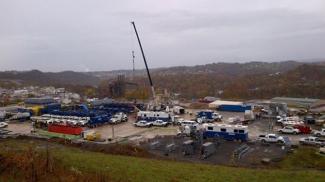NETL experts used a suite of sophisticated data-gathering instruments at the Marcellus Shale Energy Environmental Laboratory (MSEEL) near Morgantown, West Virginia, to secure a greater understanding of emissions and dispersion rates of various compounds — geological and environmental systems research that could help avoid future adverse impacts on local and regional air quality where unconventional oil and gas activities are underway.
By providing a complete understanding of the impacts of oil and gas development on regional air quality, the Laboratory can help ensure that development proceeds at a rate that protects the environment while ensuring an adequate domestic supply of oil and gas.
Recent technological advances in horizontal drilling and hydraulic fracturing have made recovery of large quantities of natural gas in shale formations economically feasible. Production from shale gas and associated gas from tight oil plays in the United States is the largest contributor to natural gas production growth and is projected to account for nearly 40 percent of U.S. energy production by 2040.
NETL’s MSEEL work is important because of the vast area where the Marcellus Shale play exists and the potential it holds for future natural gas production. According to the U.S. Energy Information Administration, the Marcellus Shale play extends in the subsurface from New York State in the north to northeastern Kentucky and Tennessee in the south and is the most prolific natural gas-producing formation in the Appalachian basin. The formation footprint covers about 95,000 square miles with a prospective area of about 72,000 square miles.
Natalie Pekney of NETL’s Geo-Analysis and Geo-Analysis & Monitoring Team, explained that oil and gas activities prevalent in the Appalachian Region generate emissions of various compounds from engines used to drill and conduct hydraulic fracturing, on-site gas processing and the flowback of water used in the fracturing process, venting, flaring and fugitive emissions of natural gas. Those compounds include nitrogen oxides, volatile organic compounds and particulate matter, methane and carbon dioxide.
“Oil and gas operators need specific data to help them reduce emissions and fugitive releases of gas,” she said. “But, because emissions have discernible differences according to specific activities, we needed an assessment of emission trends that can be used as a tool to guide oil and gas operational performances.”
NETL used an arsenal of high-tech equipment to gather emissions data and analyze the results, like a stationary ambient air monitoring laboratory, vehicle-based methane plume surveying equipment and infrared cameras to collect data for use in numerical models. The data provide an understanding of emission and dispersion rates that could impact local and regional air quality and allow researchers to compare trends under a range of operational scenarios.
NETL deployed its Mobile Air Monitoring Laboratory to the MSEEL site in Morgantown, West Virginia — a collaborative project with West Virginia University, The Ohio State University and Northeast Natural Energy that created a dedicated field and laboratory production site in the center of the Marcellus Shale region of north-Central West Virginia. MSEEL offers a long-term site for well-documented baseline of production and environmental characterization from two wells.
Key findings of the measurement and analysis activities were:
- The greatest impact from methane and volatile organic compounds occurred during flowback from fracturing at the MSEEL site.
- Analysis led to the conclusion that peak concentrations of methane and VOCs observed during flowback are from activity on the well pad and not from other off-site sources.
- Emissions attributed to combustion engines were highest during drilling and production stages.
- Access road traffic is a source of nitrogen oxides (NOx) to areas near the well pads.
- Well pad activities affect local ammonia concentration dynamics and are more likely to occur during phases where large diesel engines are used.
- The MSEEL operator used the industry’s current best management practices, making the study an example of a best-case scenario for nitrogen deposition surrounding a well pad.
The innovative research taking place at the MSEEL site is just one example of how NETL is working to develop advanced technologies that provide affordable, reliable, home-grown energy to the American people. The innovations that NETL and its partners discover address a range of fossil energy challenges, including effective resource development, efficient energy conversion, and results-oriented environmental sustainability.




